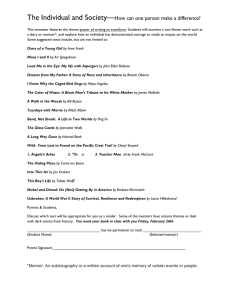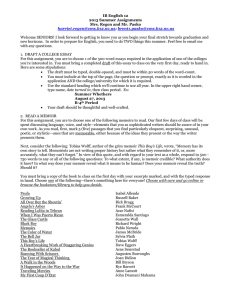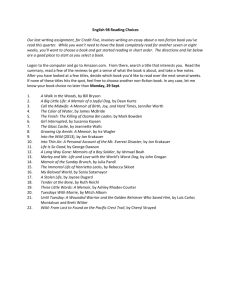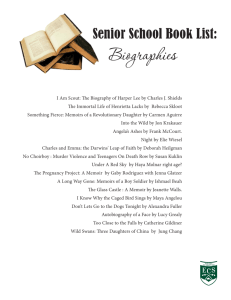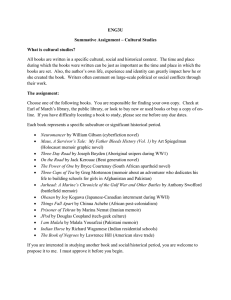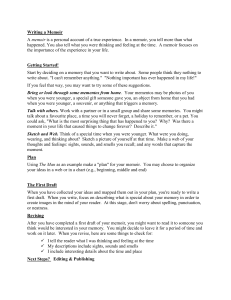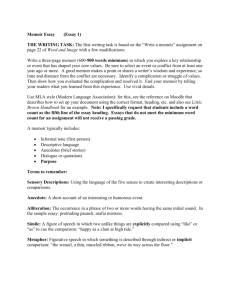File
advertisement
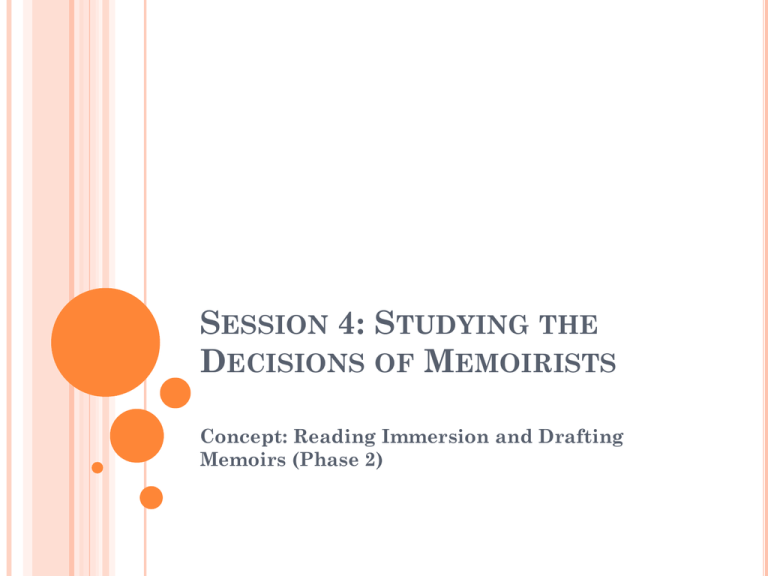
SESSION 4: STUDYING THE DECISIONS OF MEMOIRISTS Concept: Reading Immersion and Drafting Memoirs (Phase 2) TEACHING POINT Copy in NB: What is truth? Memoirists determine how much truth is too much truth as well as what truth will be expressed. They identify the honest view, and then they decide what a reader needs to know to understand the larger point of the memoir, and what a reader does not need to know. Deciding what not to include is as important as what to include. TODAY’S QUOTE Everyone can learn to become comfortable putting words and thoughts down on paper. Writing doesn’t have to be a struggle. - Peter Elbow MEMOIR MODEL: LOOKING FOR A “TRUTH” Together, let’s read David Sedaris’ “Big Boy” – a memoir about a bathroom trip What truth about himself do you think he is exploring – even though this is a funny episode in his life? Highlight words or thoughts that show his “truth”. How is this model memoir “honest”? What details make it “honest”? TURN & TALK - PARTNERS What is the truth the writer is revealing? Do you think the writer is honest enough? Too honest? What sentence seems to be most truthful? What detail? YOUR TURN – FREEWRITING FOR MEMOIR Our goal? Identify a “truth” about ourselves. First, glue in the “Track a Truth” clip to your NB. Step 1: Make a List. What is going on with me right now? Is there anything in the way of my writing today? Make a list of the distractions that might slow your writing process. GUIDED PRACTICE, CONT. Step 2. Make a list or freewrite. What’s on my mind? What might I write about? If you get nothing, ask what is this nothing all about? Step 3. Make a list or freewrite again. What other possibilities for writing have I left out? READ, WONDER, PAUSE, JOT TO FIND A TRUTH…AND WRITE AGAIN Read your draft. Ask: Where are there surprises? What additional truth does this surprising detail suggest? These are not huge surprises or huge truths. Look for everyday truths. Reread the entry pausing to reflect. When you find a surprising detail, action, or observation, pause and jot a thought or truth in the margin. Use that process: Read, pause, jot as if you are talking back to the text you just wrote. You know what to do next. Write again. Start with stating a truth and write to surprise yourself one more time. READ, REFLECT, AND DRAFT A MEMOIR NOW: Read your lists and/or freewriting and star lines/words that seem important. Then review those starred lines/words and highlight a line or two that suggests a subject or idea. Write a sentence on the top of a clean notebook page stating a simple truth about you. Identify an event in your life connected to this truth Tell the story of this event to illustrate what you know is true about you. Insert thoughts as they occur. REFLECTION #4 Date your reflection and answer ONE of the two reflection questions: Option 1: Finding Truth As you tracked surprises today, what truth did you discover? What details or thoughts reveal that truth? Have you said all you want to say? Have you said too much? Option 2: Memoirist’s Process How does this process help me find important stories that matter and understand why they shape who I am? How is this process challenging?
